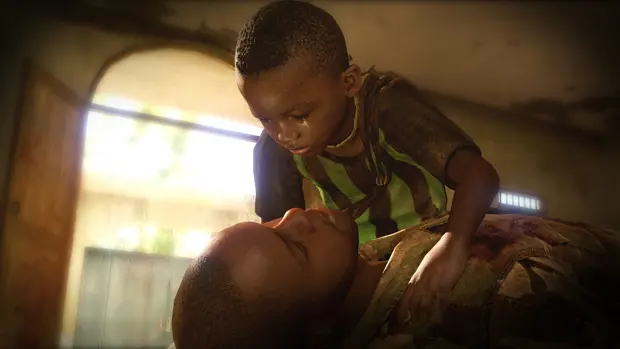 In recent years, video games have caught up to theatrical films as a long-form storytelling medium. With epic, story-based games like Grand Theft Auto V, the Uncharted and Assassin’s Creed franchises, and even the solo campaigns of Call of Duty and Battlefield, making waves–and money–developers are scrambling to find ways to further blur the line between what we play and what we watch.
In recent years, video games have caught up to theatrical films as a long-form storytelling medium. With epic, story-based games like Grand Theft Auto V, the Uncharted and Assassin’s Creed franchises, and even the solo campaigns of Call of Duty and Battlefield, making waves–and money–developers are scrambling to find ways to further blur the line between what we play and what we watch.
Enter French developer, David Cage and QuanticDream. Cage began pushing the envelope in 2010’s Heavy Rain. In that game, the player took control of four characters and worked their way through a story that involved the hunt for a twisted, maniacal, child-murdering serial killer. Heavy Rain’s story was influenced by the decisions of the player, and it was entirely possible for two people to play the game and get completely different experiences. I say this from experience, having witnessed it firsthand.
This brings us to the newest project by Cage and QuanticDream, Beyond: Two Souls. Once again, Cage, who writes and directs, tasks gamers with guiding the story–not the main character–to a satisfying conclusion. Even with a cast that includes Academy Award Nominees, Ellen Page (Juno) and Willem Defoe (Platoon, Boondock Saints, Spider-Man), the acting, which is incredible, as to be expected, and the spectacle of the story take a back seat to the narrative and how the user manipulates–for lack of a better word–the game to its end.

Page stars as Jodie Holmes, a gifted young woman who has the luxury of being tethered to an “entity” named Aiden. With Aiden, Jodie has a protector from the “other side” (here called the Infraworld), who can manipulate objects, possess certain people, and even kill when needed. During the game, the player can press the triangle button and take control of Aiden. This adds a new level of play control, as Aiden can go through walls, see spectral residue, and go places and do things that Jodie cannot.
Because of this unique gift, the U.S. Government quickly latches on to Jodie at a young age in the form of DPA (Department of Paranormal Affairs) researcher, Dr. Nathan Dawkins (Defoe), a man who is interested in learning all he can about the Infraworld from Jodie. When tragedy strikes Dawkins’ world, Jodie and her gift becomes that much more important.
As we follow Jodie’s story, we see her later get recruited by the CIA, as her gift makes her the perfect operative for covert missions, as Aiden can get into places undetected and do things that a living, breathing human could not. After Jodie learns that she was manipulated during an important mission, she goes AWOL and the CIA work diligently to reacquire their “asset.” Jodie, alone and on the run, must learn to survive at all costs.

The story is satisfying in its own right, but the problem lies in how it is told. We play as Jodie during three distinct periods of her life. The youngest is at age nine (here played by Caroline Wolfson) and the oldest is at 25 (and older, in a quick scene during one of the game’s many endings). This would work, but for some reason, David Cage opts to break up Jodie’s life into a non-linear narrative that fails to work as intended. We meet Jodie at 22, and then go back to age nine. Then we jump to 14 and then back to 22 and then 14 then nine; you get the point. The skipping around doesn’t serve the story at all and in fact makes for a discombobulated experience.
One great example of this is a major plot point–one that happens when Jodie is nine–happens in game time right before the endgame climax, when Jodie is in her twenties. It’s almost as if Cage didn’t trust his audience to remember the point–OR–he added it late to accentuate the emotions of the climax. Either way, it’s terrible storytelling, and in a game based 90% on its ability to tell a story, it’s a major failure.
To add insult to injury, once the game is completed to one of the many endings, the player can then choose to replay the entire game, chapter-by-chapter, and can then choose how to see and play the narrative. I did this and found my experience completely different when I played closer to chronological order. Unfortunately, most gamers won’t give Beyond: Two Souls that kind of second chance, and will dismiss it as a veritable mess of storytelling, which it is.

Now, with all of that being said, Beyond: Two Souls is, by far, one of the best looking games I have even seen in this–or any–generation. The character models look incredibly lifelike, and the work that QuanticDream did with Heavy Rain, itself a marvel of graphics, has advanced so far that even the character’s eyes have a semblance of soul, replacing that blank, soulless look that most games are able to pull off. The water/rain effects look photo-realistic, and some of the later stages, especially the chapters that involve the Infraworld are exquisitely beautiful in their detail. There were countless times during my play through that I had to remind myself that I was playing on a system at the end of its lifecycle. If QuanticDream can get this kind of power out of the aged PS3, what are they going to be able to do on the infinitely more powerful PS4? The mind boggles.
As for the play control, this is another issue that tends to come up in debate. When you go into a QuanticDream game, it is to be expected that the player is essentially walking into a quick-time event (QTE) presentation. You are basically playing one long, beautiful, cinematic “choose your own adventure.” If gamers are expecting the controls and action of a game like GTAV, they will be sorely disappointed. Beyond: Two Souls asks players to help tell the story, not to get high scores, earn killstreaks, or to start and run a drug empire. Eighty-five percent of the game is based on screen prompts and controller manipulation. While this style of game isn’t for everybody, it is the how this game is built. You cannot fault a game for completing what it set out to do, just because you don’t like that control style coming in. It would be comparable to purchasing GTAV and complaining about the violence.
I will say that the control scheme, as defined in the previous QuanticDream games, works well, and is actually less intrusive here. It cuts both ways, as in tense story moments, the screen will go to a sepia-toned slow motion, and the player has to quickly find the button/controller prompt and execute before Jodie–the character–is shot, sliced, punched, thrown off a roof, etc. After a few hours, you do learn to anticipate these prompts, and the flow of the game takes over, but even some late stage actions get lost in the action onscreen.

Beyond: Two Souls is an ambitious game, to say the least. The story is good for what it is, but told initially in such a way that it is confusing and jumbled, which hurts it in the long run. This executive decision nearly ruins the entire production. The acting–on all fronts–is amazing, and Kadeem Hardison (A Different World) deserves praise as Cole, Dr. Dawkins’ research assistant that serves as Jodie’s “uncle” figure and her protector while she’s a kid, and later her friend and confidant as she gets older.
The graphics are the best I’ve ever seen in a game–to date–and the entire production is full of the love bestowed on it by its creators. The play control is executed as intended by the developers and, as a whole–due t the story telling problems, mostly–the entire production toes the line between masterpiece and mundane. Unfortunately, it crosses over to both, back and forth, throughout the game.
David Cage has said countless times that he is always looking for ways to push the envelope and blur the lines between playing a game and living a game. Beyond: Two Souls is as close as we have come to that goal.
Beyond: Two Souls is exclusive to the PlayStation 3 and was released on October 8, 2013.
Shop for Beyond: Two Souls on PS3 for a discounted price at Amazon.com.



